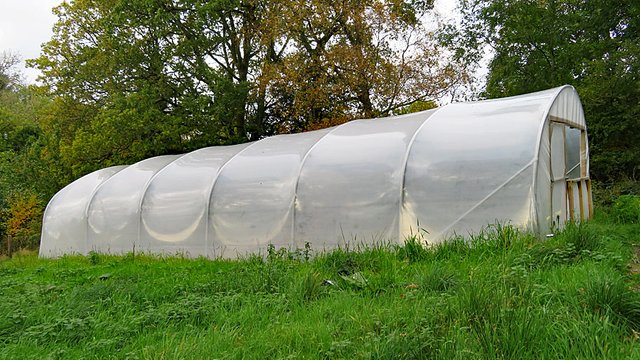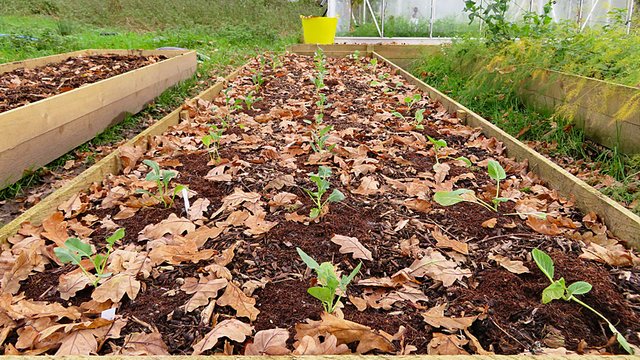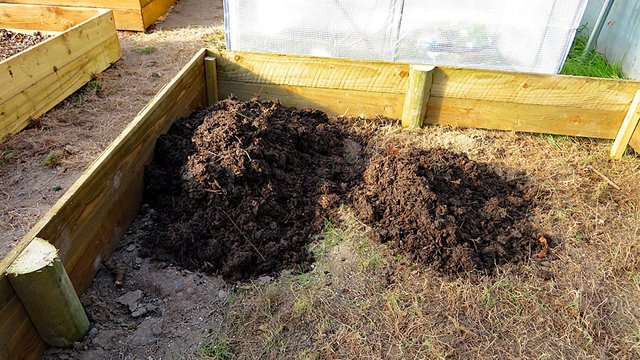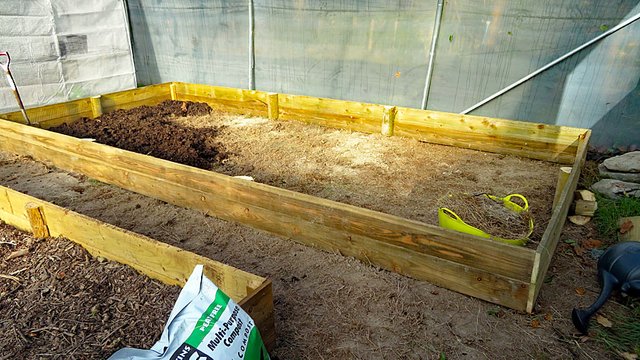Investing in the Future of our Homestead and the Economics of Raised Beds
This year has been all about infrastructure on our homestead.
We have added a polytunnel, two greenhouses and another eight raised beds. The second compound for the chickens, ducks and goose has also been constructed.

A start has also made on refurbishing the main barn, and one of the chimneys on the house has been rebuilt.
Luckily we have had the funds available to do all this. This has not been 'spare' money though. We have had to prioritise these works over other possible expenditures. We have cut back on holidays, outings and going out for meals.
We have made these choices as we believe building up the infrastructure of the homestead to be an investment. It is in effect part of our pension. If we can make ourselves more self reliant now then our living costs as we get older will be less and less. It is almost like inverse pension saving.
Spend now to save later.
Next year our big target is to invest in our energy production systems with a range of renewable technologies.
All these 'investments' have taken quite a bit of money. The polytunnel, greenhouses, chicken compound and raised beds in total have cost around £5,000 (US $6,500).
This is a good sum of money. To put it in perspective for a British family of five that is equivalent to a couple of fairly modest overseas holidays. On the flip side all the improvements in our growing capacity has allowed us to produce all our own vegetables, as well as eggs and chicken, for almost half the year - a saving of around £1,000 (US $1,300).
This brings this round to the idea of Return on Investment (ROI).
While I have not done business rigorous ROI analysis on each element of our homestead expenditure I do certainly do some back of the envelope calculations before proceeding.
Our raised beds are an example of this.
We use raised beds as we have poor soil and drainage. They are a massive multiplier for our food growing capacity.
But they do cost money.

We use two standard sizes of raised beds. The smaller ones are 1.2m x 4.8m, and the larger ones (in the polytunnel) are 2.2m x 4.8m. Originally they were at 9 inches (23 cm) depth, but all the newer ones are now 12 inches (30cm).
They are built out of pressure treated tanalised softwood. This is not my ideal choice of wood. I would much prefer to use untreated cedar or larch but the only accessible sources I have found for that have been around four times as expensive.
The dimensions of the original 1.2m x 4.8m beds were chosen as the standard longest timber length available here is 4.8m.
So for these beds I need exactly 5 lengths of the timber for the 2 x 6 inch depth. Additionally each bed uses about half a length of 2" x 2" timber for the corner supports, and a 5ft 5in half round post cut into four for the side supports.
Adding in a pound for the screws the materials cost for one of the smaller beds comes in at around £60 (US $80).
For the larger beds the materials costs rises to £75 (US $100).
Both size beds take 2 - 3 hours to make depending largely on how difficult it is to dig the post holes. If I am building them there is no labour cost other than the opportunity cost of my time. Although since my back injury I have had to bring in paid help for some jobs. If I include their time it adds another £35 (US $45) to the costs.
The final part of the costs for a raised bed depends on what I fill it with. Currently I am sourcing free material for the bulk of the filling - rotting wood, wood chips, animal manure, grass cuttings and kitchen waste. I then top off the bed with some bought in compost. It usually takes about eight 50 litre bags at around £5 each to finish a bed, giving a total compost cost of £40 (US $52).

In summary the costs for a 1.2m x 4.8m x 12in raised bed are :
- Materials = £60
- Labour = £35
- Compost = £40
- TOTAL = £135 (US $175)
This is not cheap, although if I could do all the building myself, and if I could produce all my own filling compost, the cost would be halved.
I have looked briefly at other materials such as corrugated metal sheets and posts, or concrete blocks, but it is unlikely they would be any cheaper.
Set against the costs of a raised bed I look at what that bed can produce.
The monetary value of the produce will vary considerably according to the crops grown. As a couple of examples a bed of this size is yielding at least 30kg of potatoes or about 36 good size cabbages.
I grow organically so 30kg of potatoes is worth at least £30 (US $40), while the 36 cabbages is worth around £50 (US $65). Other more high value crops good give an even higher monetary yield value.
I am getting at least two crops a year from the beds - possibly even three if I do an overwinter crop.
I am likely therefore to be getting a monetary yield value of at least £80 (US $105) per bed per year.
For the beds in the polytunnel I am hoping the monetary yield value will be even higher.
So with a setup cost for each bed of £135, and an annual crop value of at least £80, it shows that the payback time for a raised bed is less than two years.

In the polytunnel, with the bigger beds, and longer growing season the payback time is likely to be closer to one year.
Even with the addition of a small cost for seeds this is still extremely good.
The original beds we built have lasted eight years and are just now beginning to need repair or replacement. I expect with a bit of care and attention they would make ten years.
Of course looking at raised beds in purely economic terms does not factor in all the massive benefits of growing your own food - freshness, quality, nutrients, provenance, variety etc. As well as the exercise and health benefits of the gardening work involved.
Most importantly for me as well is the independence and self reliance producing your own food brings.
So for our family investing in infrastructure on our homestead only has positives all round.
We are lucky enough this year to have had the money to use for these investments. Everyone has to make their own choices of how they spend their money.
For us we can sum it up when we remember that until a couple of years ago we used to eat out regularly. For my wife and I a meal out would usually run to around £80 (US $105). If we took the children as well it would be heading towards twice that.
Now we rarely go out to eat. Instead we enjoy cooking a meal together with our own produce from our own garden.
Healthier for us, healthier for our wallet, healthier for our future.
You might also be interested in some of my other posts :
Every Picture Tells A Story : Beauty, Buffalo, Burial & Branston
The Steemit Guide to Homesteading : a Global Adventure in Collaborative Curation
Homesteaders & Preppers on steemit - 230 members and rising - v9 [08 Oct '17]
SteemTowns - connecting the virtual with the reality - would it be possible?
[all images by @pennsif]
Sound infrastructure is expensive but can be the difference between sucess and failure
Very true. I can see next year in their first full season the polytunnel and greenhouses really will pay dividends.
Awsome to see the progress and the ROI I myself have chosen small improvements for my home as well, with bringing down a dangerous tree $900 CAD, to purchasing my greenhouse $120, to adding as well 2 new raised beds, $80. and putting a fence to keep animals in and pesty rodents out, $3500. SO this year was expensive as well, but have a freezer full of fruits and vegetables to nibble on all winter. Love the post @pennsif
One day I will manage to do the same! Till then I'll keep living in my town home in Seattle. Thank you for the motivation.
Good luck. Followed you to learn more about yoga.
How are you liking the poly tunnel? I think that is going to be one of the first pieces of infrastructure I put on the homestead.
Totally enjoying it. It came late in the season for this year, but now doing some winter planting to make the best of it.
You've been very busy. Everything looks well constructed and thought planned. I may need to do raised beds this spring, my soil is not good either. Frequently I dig up all kinds I'd crap, today it was a Fram oil filter not far from the chickens. Geez!🐓
Raised beds are a must for us. I did try planting direct into the ground before but it was a total fail 😞
A new twist for us when considering infrastructure now in Australia has been termites. Wood is still cheaper, but it's treated with arsenic or cyanide. More expensive wood is still vulnerable so we end up with metal (expensive too), which heats up like an oven in summer!
Luckily we don't have termite problems in Wales - just lots of slugs (although they don't eat wood so much).
You've made some good progress this year for the future of your homestead! Those raised beds are nicely done.
Thanks, it has been a good year for progress here. Hoping we can maintain it next year...
Wow! All this work is impressive, and the cost is actually lower than I would have imagined, especially with two greenhouses! Are they all new materials?
I can't wait until I have my own place! 😀 I don't intend on doing a large-scale farm, but it will feel so good to be more self-sufficient!
With the polytunnel there is a manufacturer very close to where we live. I managed to do a bit of haggling and got a good deal 😎
For the greenhouses I got the first one in a sale, and then I got a 10% discount voucher from the company for future purchases. I used that in their next sale and got the second greenhouse even cheaper.
Nice deal!
Really great write up, and I love how you've worked out all the costs...that's how it should be done!
Also...I have polytunnel envy. As always.
It can be very useful and very enlightening to actually 'run the numbers'. It doesn't always come out how you hoped it would !
Really interesting to see the costings etc. As this is something i hope to achieve very soon.
However on a smaller scale.
Good luck. Do post with your progress.